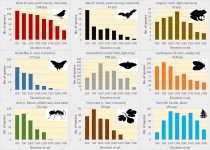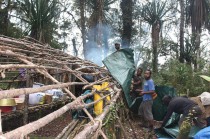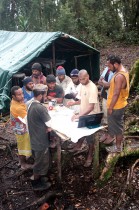Biodiversity
Mt. Wilhelm is a particularly good choice for researchers in rainforest ecology and anthropology, bird watchers and other naturalists (and for hard-core hikers).
- Interaction web between plants (bottom) and ants (top) from 700 to 1500 m asl.
- Elevation trends in species diversity for selected taxa at Mt. Wilhelm
- Sampling insects from Ficus trees
- Legi Sam managing data in the Numba camp
- Porters with cargo on their way between two camps
- Dangers of driving on PNG roads (not our car though)
- Paraecologist Bonny Koane in the field, presenting at the Association for Tropical Biology Conference, and co-authoring research papers
- Ficus saplings waiting to be transplanted 500 elevation m above or below their natural range
- Rate of attack (mostly by birds and ants) on plasticine caterpillars: caterpillars are safer on intact than damaged foliage, and predation pressure decreases with elevation
- Yes Density of insects (relative to control) after one year of bird and bat exclusion, using a net: increased to 180% of original values in the lowlands and 120% at the timber line.
- Plant-caterpillar food web from 200 m asl. (bottom: Ficus spp, top: Lepidoptera spp.)
- Ratio between the total number of species along Mt. Wilhelm transect and the highest number of species at one elevation (an indication of how much elevation contributes to overall diversity)
- BRC paraecologist Andrew Kinibel rearing insects at Mt Wilhelm
- Field camp at 2700 m asl.
- Building a field camp at 2700 m asl.
- Sampling insects from the foliage using a beating tray
- Last instructions before going for field insect sampling
- Self-explanatory, no caption needed…





















